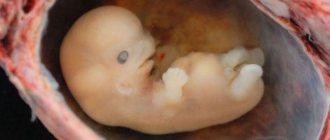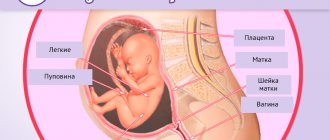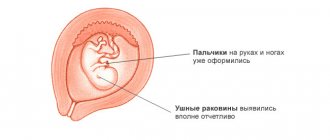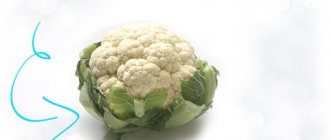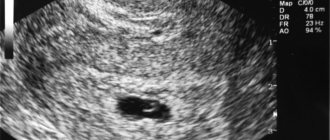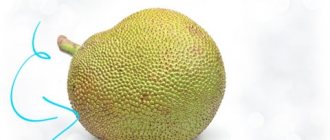Home / Health / Pregnancy
Back
Published: 01/22/2020
Reading time: 7 min
0
986
5 / 5 ( 1 voice )
The 8th week of pregnancy is different in that the expectant mother’s sense of smell is very pronounced. Again, the hormones that continue to rage during this period are to blame. We learn from the article what happens to the fetus and what sensations the woman experiences.
At 8 weeks, the baby is already the size of a large cherry. Of course, you don’t feel it, but the child is already moving, he is also developing and growing very dynamically.
Another week of your pregnancy has passed. Congratulations! Every day your child becomes more and more like a little person. Signs of pregnancy are already clearly visible. The belly is softly rounded and the breasts have taken shape.
If you haven't been to the doctor yet, the 8th week of pregnancy is the ideal time to visit. The gynecologist will probably prescribe examinations: urine analysis, morphology, blood group analysis, and possibly refer you for the first ultrasound.
- What happens to the fetus: baby development day by day
- 8th week of pregnancy: signs and sensations of a woman
- Belly size at 8 weeks of pregnancy
- Recommendations for the expectant mother
- Vitamins for early pregnancy
Feelings of the expectant mother at 8 weeks
The 8th week of pregnancy is the best time to register with the antenatal clinic.
During the initial visit, all important examinations of the expectant mother are carried out: the gynecologist will measure the woman’s pelvis and weight, conduct an examination on the chair, take a smear for infections, assess the condition of the cervix and give directions for blood and urine tests. Ultrasound at the 8th week of pregnancy is only indicated if you did not have time to do it earlier (for example, to clarify the pregnancy). First trimester screening is carried out a little later - at 11-13 weeks of pregnancy. At 8 weeks of pregnancy, the expectant mother's belly may periodically ache.
: Some women notice slight contractions of the uterus (early training contractions) and unpleasant pain associated with stretching of the ligaments that hold the growing uterus.
Nagging pain in the lower abdomen is a serious reason to consult a doctor, as their appearance may indicate a threat of miscarriage!
How, what and how much to eat?
Menu for pregnant women for a week
A complete diet is based on the well-known nutrition pyramid with some adjustments.
So part of the daily diet (40%) consists of grain products: whole grain bread, biscuits (how much is possible?), durum wheat pasta and porridge with water or milk half and half with water. In this case, the consumption of white bread and other yeast products must be excluded or sharply limited.
Good porridges for this period include buckwheat, pearl barley and oatmeal. This is especially true if a pregnant woman suffers from constipation.
The second part of the pyramid consists of fresh vegetables and fruits. They make up 35% of the total diet. In this case, you should limit your consumption of allergenic foods: oranges, lemons and other citrus fruits, strawberries, tomatoes. So one orange won’t make your child feel bad, but you should still refrain from eating a kilogram. Since there is a high risk of intolerance and allergic reactions in the baby.
The third part of the diet was divided between meat, fish, egg and dairy products. Their share in the diet should be at least 20%.
Vitamins at 8 weeks of pregnancy
Meat is the main source of protein. However, during pregnancy it is better not to burden the liver and gall bladder with fatty and high-calorie foods, such as lamb. Lean veal, turkey (for example, meatballs), and chicken have good nutritional value.

Products containing calcium
At the same time, it is better to avoid dried, smoked, and raw meat delicacies (stroganina, smoked ham and even sausage!). Not only is there too much salt and spices, but the ingredients may also contain unsafe additives. They have a detrimental effect on the baby, leading to various developmental pathologies.
Steamed, baked or stewed sea fish will compensate for the lack of omega fatty acids and phosphorus. They are important for the full brain activity of the expectant mother.
Milk and dairy products contain calcium and a decent amount of protein (about protein nutrition). Calcium strengthens the skeletal system, and protein serves as a building material for the body. In addition, regular consumption of fresh yogurt or kefir helps normalize stool. Which is very important, since starting from the fifth week of pregnancy the intestines become sluggish.

Vitamins in foods
The smallest part, about 5% of the diet should be given to vegetable and animal fats and sweets. It is better to replace butter with olive oil.
During pregnancy, it is necessary to minimize the consumption of chocolate, sweets, and sugar. They lead to overexcitation of the nervous system, which negatively affects the child. In addition, excessive consumption of glucose-containing foods can lead to problems with the pancreas not only of the mother, but also of the baby.
The 8th week of pregnancy is characterized by increased stress on the stomach, so the number of meals should be increased to 5-6 times a day, reducing portions.
How a woman’s body changes by the 8th week of pregnancy
At this stage, the expectant mother’s breasts have already enlarged; under the influence of the hormone prolactin, the glands responsible for the production of mother’s milk begin to grow. From the 8th week, the cervix softens, and the mucous membrane of the cervical canal produces cervical secretion. The mucus accumulates and becomes thick, forming a plug and blocking the path of any infection from the vagina, thereby protecting the growing fetus. By the way, the removal of a plug from the cervical canal is one of the harbingers of impending childbirth.
Toxicosis, bloating and other delights

The 8th week of pregnancy is often accompanied by toxicosis, bloating and constipation. In this regard, nutrition should be light and not burdensome for the stomach of the expectant mother.
Ginger tea and small consumption of walnuts will help with nausea. Nuts are very high in calories, so you should not overdo them.
Dill water or fennel teas will help relieve bloating. You should also exclude gas-forming foods from your diet: peas and all legumes, cabbage, yeast bread.
Large amounts of fruits, vegetables and fiber (whole grain cereals and bread) help relieve constipation. Lean on beets and drink prune infusion, drink a glass of raw water or kefir on an empty stomach at night.
The 8th week of pregnancy is a very important stage for the health of not only the child, but also the mother. After all, this period is one of the critical periods in the life of a pregnant woman.
By protecting the baby from the digestive side, the expectant mother will minimize the risks of an unfavorable pregnancy outcome and give herself and the baby good health.
Next: The optimal menu for the 9th week of pregnancy.
What happens to the embryo at 8 weeks of pregnancy
The 8th obstetric week of pregnancy is the period when the fetus develops its genital organs and produces the hormones necessary for their proper functioning. Right now, the optic nerve begins to emerge in your future baby, muscle tissue and bones continue their active development, olfactory receptors are born in the small nose, and taste buds are formed on the tongue. The fetus at the 8th week of pregnancy has reached the size of a small grape and already weighs about 0.25 g.
Weight gain at 8 weeks of pregnancy ranges from 0.7 kg (with a BMI of more than 26) to 1.6 kg (with a BMI of less than 19.8). To calculate your individual weight gain at 8 weeks, use the pregnancy weight gain calculator.
Belly at 8 weeks pregnant
The appearance of the abdomen at the 8th week of pregnancy will depend on the woman’s body constitution. Basically, the majority of expectant mothers have a small tummy, but it is already quite noticeable. A woman should understand that the period from the 8th to the 12th week of pregnancy is considered the most vulnerable for the fetus. If development conditions are unfavorable, placental abruption may occur and, as a result, miscarriage. Signs of danger for the baby inside the womb include pain in the abdomen and lower back, as before the onset of menstruation. With such symptoms, bleeding may occur. In general, if you have such symptoms, you should definitely get medical advice and provide your body with complete rest.
What does the fetus look like at 8 weeks of pregnancy?
By week 8, the Baby’s growth reaches 6-7 mm:
- he already has lips...
- ...and even the tongue!
- baby teeth are formed;
- the esophagus, stomach, intestines, and anterior wall of the abdominal cavity are formed;
- the heart continues to form in the chest cavity: a one-way blood flow through the heart is established, the division of the heart into chambers is almost completed, the heart is functioning;
- the rudimentary circulatory system begins to function;
- the hands and feet are shaped;
- the baby’s first movements become noticeable on ultrasound;
- a bulge of the head is formed;
- on the front surface of the body, two ribbon-like thickenings can be identified, called “milk lines”;
- The brain develops in the head, and with the help of special equipment it is already possible to record its activity!
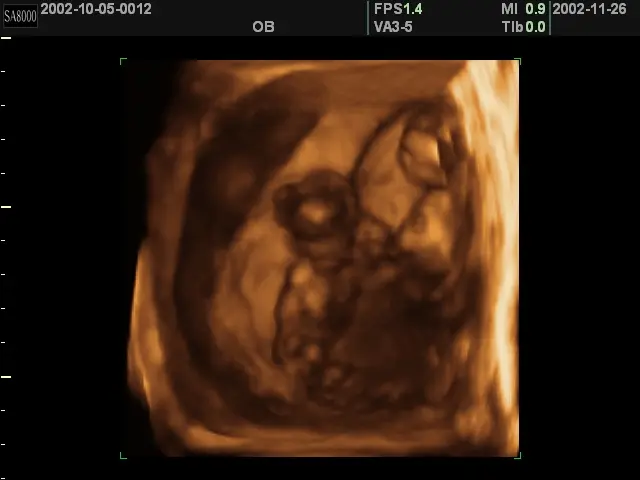
Baby at 8 weeks pregnant
Fetal size and development
At week 8, there is a rather sharp jump in the growth and weight of the fetus: its length reaches 14-20 mm, and its body weight is already as much as 3 g. Just seven days ago, the future baby weighed less than one gram, so the increase is truly significant.
At this time, the following changes occur in the body of an actively growing and developing fetus:
- the heart from two chambers becomes four chambers, as it should be in all mammals and humans;
- fingers and toes are clearly visible on the arms and legs;
- the intestines are significantly lengthened;
- the stomach is located in the abdominal cavity;
- in boys, testicles begin to form, in girls, ovaries;
- salivary glands are formed;
- the process of forming the ears begins;
- The bronchi begin to branch inside the lungs;
- buds are formed;
- the birth of the optic nerve occurs.
information At 8 weeks the baby begins to move in the uterine cavity for the first time. Of course, the woman does not yet feel the first movements, since the fetus is still very tiny, but with an ultrasound, the doctor can clearly determine its movements.
Useful advice for an expectant mother
The baby's body is formed from the mother's egg and the father's sperm, so it is half a foreign organism for the woman.
In order not to reject the “alien”, the expectant mother’s body reduces its immune defense. Therefore, the words “you need to take care of yourself” will have to be made a motto before, during and after the birth of the Baby. You can identify a decrease in immunity by a feeling of chronic fatigue and pain. So that it doesn’t take you by surprise, start strengthening your body in advance.
- Tune in to the process of self-healing of the body, in any case, do not slow it down. An attempt to get rid of unpleasant sensations using medical methods can serve as a brake. To begin with, what is happening (for example, drowsiness, nausea, irritability) must be accepted as a kind of “requirements” of the Baby with regard to mother’s rest, nutrition, and lifestyle. When these simple “requirements” are met, many sensations disappear. However, if they appear over a long period of time and intensify, then the Baby needs help and should consult a doctor.
- Get more sleep: sleep at least 8 hours daily. It makes sense to go to bed no later than 23:00: the sooner you begin to accustom your Baby to the correct sleep-wake schedule, the greater the chance that he will not “confuse day and night” in the first months after birth. In addition, his nervous system, if he follows the regime, will be stronger, which means his overall vitality will be higher.
Small uterus and pregnancy
Unfortunately, not all women manage to get pregnant without difficulty and carry a healthy baby. The reasons for such difficulties are various diseases associated with the reproductive organs, as well as the hormonal characteristics of women. For example, uterine hypoplasia, that is, an underdeveloped, small uterus. What to do if you have been diagnosed with this, as well as the causes and useful recommendations, will be discussed in this article.
The causes of uterine hypoplasia in an adult woman can be diseases that she suffered in adolescence, when the formation of the reproductive organs took place. These include: hormonal imbalances, infectious diseases of the genitourinary system and genital organs, diseases of the nervous system, as well as insufficient amounts of certain nutrients in the body. The latter refers to a situation where a girl at a young age limits herself to nutritious food, thereby causing a deficiency of essential elements in the body.
In order to determine how developed the uterus is, you need to undergo an examination by a gynecologist and take measurements of the uterus using an ultrasound. However, there are some peculiarities here too. It is important to note that nulliparous women have a significantly smaller uterus than those who have successfully given birth. In addition, given the proportions of each woman, the size of the uterus is naturally very different. For a small woman with a small weight, small sizes will be considered normal, and for a woman with larger shapes, therefore, significantly higher. Therefore, only a specialist can determine the presence or absence of uterine pathology.
More on the topic
Dimensions of the uterus during pregnancy
What is uterine tone during pregnancy?
Deflection of the uterus and pregnancy
Causes of uterine tone during pregnancy
Contraction of the uterus during pregnancy
As for pregnancy, with uterine hypoplasia, there are controversial opinions. Doctors are inclined to believe that with uterine hypoplasia, the risk of a difficult pregnancy, or even the absence of one, increases. However, according to statistics, uterine hypoplasia does not contradict pregnancy and fertility. Very often, women only find out after giving birth that their uterus was not large enough to bear a child in the first place. Therefore, there is no need to get upset in advance. If, apart from uterine hypoplasia, no pathologies are identified, there is no reason to worry. But if the diagnosis of hypoplasia is accompanied by pathology of the fallopian tubes or insufficient development of the genital organs, treatment should be carried out immediately. The fact is that these diseases lead to complications during pregnancy and also provoke ectopic pregnancy.
Note that uterine hypoplasia and all diseases associated with it are very treatable in modern medicine. Most often, specialists prescribe hormonal drugs that help not only to formulate the correct hormonal levels, but also help to increase the size of the uterus. In some cases, uterine hypoplasia can be treated with vitamins without resorting to hormonal treatment.
Some women with uterine hypoplasia may be offered to increase the size of the uterus using gynecological massage. The principle of this method is an intensive massage of the reproductive organs both externally and internally. Thus, during the procedure, blood circulation is stimulated, which makes it possible to slightly enlarge the small uterus.
Well, the last thing you should pay attention to is your own attitude towards a positive result. There is no need to despair if treatment takes a little longer than you would like. Tune in to the fact that you will definitely succeed. Arm yourself with patience and the support of your loved ones - don’t worry, believe in yourself and everything will be fine. Good luck and good health to you. And let another pair of happy eyes and a small, tiny bundle of happiness appear on earth - your baby.
Especially for beremennost.net - Ira Romaniy
Tests and studies during pregnancy
Pregnancy test (urine) - if menstruation is delayed or 7-10 days after expected conception.
Blood test for hCG (human chorionic gonadotropin) - from the 7th day after conception. The content of this hormone in the blood increases sharply during pregnancy and is considered one of the most reliable methods for diagnosing pregnancy.
Ultrasound (ultrasound examination) - 5 weeks after the first day of the last menstruation, according to indications. Diagnosis of pregnancy, exclusion of ectopic pregnancy.
Blood test for AIDS (HIV), syphilis (RW), hepatitis B - when registering for pregnancy (antenatal clinic, specialized medical center, advisory clinic at a maternity hospital, etc.). These diseases can complicate the course of pregnancy and require a special approach to patient management.
Analysis for blood group and Rh factor - when registering for pregnancy. If there is a risk of Rh conflict (if the woman has a negative Rh factor and the husband has a positive one), pregnancy requires special monitoring.
General and biochemical blood test, blood sugar test - when registering for pregnancy. They give an idea of the general health of the pregnant woman and possible chronic diseases.
General urine test - when registering for pregnancy, then before each visit to the doctor. Indicates the quality of kidney function.
Vaginal smear - when registering for pregnancy. Assessment of microbial flora, exclusion of urogenital infections.
Tests for urogenital infections - according to indications .
Hormone analysis - according to indications .
What tests should you take at the 8th week of pregnancy?
At the 8th week of pregnancy, doctors recommend that women undergo the following types of tests:
1. Biochemical blood test. With its help, the condition of the internal organs of a pregnant woman is assessed. Such a study allows you to find out exactly which microelements the expectant mother’s body lacks.
2. Several types of urine tests. The Nechiporenko system option will help identify hidden inflammatory processes. A general urine test will help doctors assess the condition of a pregnant woman’s kidneys. Finally, testing your urine for sugar will allow you to accurately determine the level of glucose in your blood.
Good to know
What to do if you suffer from toxicosis?
Frozen pregnancy: signs and causes
Ultrasound in early pregnancy
Threat of miscarriage. How to avoid the threat?
Early pregnancy and threat of miscarriage: is it necessary to treat?
Several important rules of behavior during pregnancy
All texts for pages about mother and baby were kindly provided by RAMA Publishing - these are chapters from the book by Svetlana Klaas “Your Favorite Little Man from Conception to Birth”, reviewer Irina Nikolaevna Kononova, Candidate of Medical Sciences, Associate Professor of the Department of Obstetrics and Gynecology of the Ural State Medical Academy (Ekaterinburg).
I'm enjoying myself and my pregnancy
My baby!
Your presence fills my heart.
And we continue our common path forward to your wonderful birth. You already look like a tiny bean, 1.4–1.8 cm long and weighing 11 g. The first features appear on your face - eyelids have appeared, the tip of the nose and nostrils, and the mouth have stood out. The inner ear and auricles are formed. The valves of the aorta and pulmonary artery operate in the heart. And it gives me great joy to know that all the organs have formed in your little body. The first important period in our journey has been completed.
You are very close to my mother’s heart, and I protect you with it from all adversities and misfortunes. Our hearts are so close to each other. They are connected by an invisible thread of love. And it will always be like this, even when you grow up and fly away from your parent’s nest.
In the meantime, let's continue our journey! Together we are moving towards the moment when I will hug you for the first time and hear your heart beating. And now I enjoy every moment of life... And I give moments of joy to myself, and therefore to you, in every beat of my heart. Grow, my beloved baby!

“The Miracle of a New Life” is a coloring book for expectant mothers from psychologist, best-selling author of books for mothers Tatyana Aptulaeva and illustrator Alena Ustinova.

